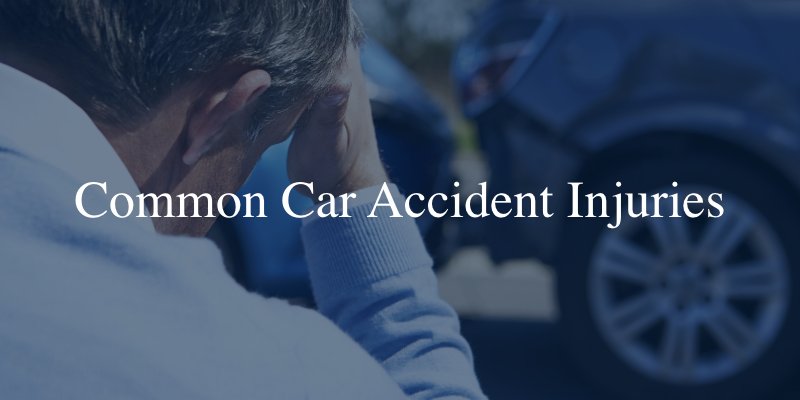Common Car Accident Injuries
Request a Free ConsultationSeatbelts undeniably save lives by preventing motorists from becoming projectiles in a car accident, but the crash force of a collision places tremendous stress on the human body, despite the protection of a seatbelt and airbags. According to the crash force calculator developed by the Montana Department of Transportation, a 100-pound person becomes a 3,000-pound force in a collision at only 30 miles per hour. This force propels the body forward against the seatbelt and then snaps it back against the seat cushion—all while the interior structures of the car crash inward with forceful impact from multiple angles. Even a relatively minor fender-bender can cause painful injuries such as whiplash and back injuries. More serious car accidents such as side-impact collisions, head-on collisions, and rollover accidents cause severe, sometimes catastrophic injuries.
After a car accident, it’s important to have a detailed medical report of your injuries and their impact on the ability to earn a living and accomplish routine daily tasks. Speak to an injury lawyer in Cherry Hill to learn more.
What Are the Most Common Injuries in Car Accidents?

In 2022, there were over 283 million vehicles registered in the United States and 46,027 car accident fatalities. That same year, over 5.2 million motorists sought medical attention for car accident injuries. Common car accident injuries requiring medical attention include the following:
- Fractures, including broken bones in the limbs, pelvis, hips, ribs, and clavicle (collar bone)
- Whiplash and other neck injuries caused by the over-extension of the neck as the weight of the head snaps back and forth in a collision
- Back injuries, including herniated discs, fractured vertebrae, misalignment, facet-joint injuries, spondylolisthesis, and sprains and strains
- Facial injuries
- Concussions and other head injuries
- Internal organ injuries
- Knee injuries
- Shoulder injuries
- Ankle injuries
- Wrist injuries
- Lacerations and bruises
- Soft tissue injuries
Any of the above injuries can range from mild to serious injuries requiring medical care, medical procedures, and sometimes rehabilitation and ongoing care to achieve maximum medical improvement. Car accident victims with the above injuries may fully recover or may experience permanent impacts from their injuries.
When car accident injuries require medical care and lengthy recovery times, the injury victim may face expensive medical bills at the same time that they are unable to return to work due to their injuries and damage to their vehicle. Even relatively minor injuries can quickly cause financial hardship for car accident victims and their families. More serious injuries can have longer-lasting or permanent physical, emotional, and financial impacts on the victim. These consequences of an accident are known as the injury victim’s “damages” in a car accident claim or lawsuit.
Catastrophic Car Accident Injuries
While most common car accident injuries are those from which victims fully recover with proper medical treatment and rehabilitative therapies, some car accident injuries cause life-altering or catastrophic injuries. The most common severe or catastrophic car accident injuries include the following:
- Traumatic brain injuries such as a severe concussion or “long-concussion,” diffuse axonal brain injury, coup-contrecoup brain injury, penetrating brain injury, hemorrhage, or skull fracture
- Spinal cord injury causing partial or total paralysis, (paraplegia and quadriplegia)
- Burns
- Internal organ damage
- Loss of vision or hearing
- Traumatic limb loss
- Permanent disfiguring facial trauma
- Multiple complex fractures
When car accident injuries result in serious, life-altering consequences, disability, or significant impairment, the victim can achieve compensation and a sense of justice for their losses through a car accident claim or lawsuit against the driver responsible for the accident.
When is a Driver Liable for a Car Accident Victim’s Damages?
Most states are fault-based car accident states allowing car accident victims to file for compensation for their damages against the at-fault party’s insurance; however, New Jersey, Florida, and a handful of other states have no-fault insurance systems that require car accident victims to file claims against their own personal injury protection (PIP) car insurance policies. However, depending on the severity of the injuries, whether or not the victim’s expenses far exceed the limits of their policy, or the terms of the policy they chose, accident victims in no-fault insurance states like New Jersey may still be able to file claims or lawsuits in civil court to recover compensation for their damages. A successful claim to cover damages for common car accident injuries requires documenting evidence of liability, or showing the following:
- That the at-fault driver had a duty of care to the injury victim and others on the road to take reasonable measures to prevent causing an accident and injuries
- They breached this duty through an act of negligence
- Their negligent breach of duty directly caused the accident and the victim’s injuries
- The injury victim suffered significant economic and non-economic damages from the injuries
Once a car accident attorney has proof of liability, they carefully scrutinize the injury victim’s medical records and consult with medical experts about the impacts of the injury on the victim’s ability to work and accomplish daily tasks as well as the level of pain and suffering commonly associated with the injury until the victim reaches maximum medical improvement.
What Damages Are Associated With Common Car Accident Injuries?
When a car accident victim suffers significant or severe injuries, the consequences are both economic and non-economic. Common economic damages in car accidents include property damage, medical expenses, future medical costs, and past and future income loss. In cases of severe injury and disability, economic damages could also include diminished future earning capacity. These economic damages are tangible and relatively easy to calculate for compensation.
Non-economic damages are intangible and more difficult to assign a monetary amount, but they are often the most devastating effects of a car accident on the victim. Common non-economic damages in car accident claims include pain and suffering, PTSD, emotional trauma, disfigurement, loss of one of the senses, loss of limb, or loss of enjoyment of life. Financial compensation for non-economic damages cannot erase pain, trauma, and disability, but it does substantially increase the injury victim’s compensation after a car accident and opens the door to the best care while relieving financial hardship. It also helps car accident injury victims to achieve a sense of justice and accountability.
Call a Car Accident Attorney If You’ve Suffered Injuries
Insurance companies rarely pay the full amount of compensation available to victims. Instead, they commonly dispute or underestimate claims. An experienced car accident attorney like the client advocates at Grungo Law can help you or your injured family member recover full compensation for economic and non-economic damages. Call our Cherry Hill accident lawyers today for a free consultation.
